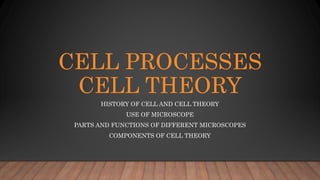
cell and Cell Theory importance ppt.pptx
- 1. CELL PROCESSES CELL THEORY HISTORY OF CELL AND CELL THEORY USE OF MICROSCOPE PARTS AND FUNCTIONS OF DIFFERENT MICROSCOPES COMPONENTS OF CELL THEORY
- 2. CELL • Basic units of structure and function in living things • Building blocks of life Because you are alive, you are made up of cells One square centimeter of your skin’s surface contains over 100,000 cells
- 3. HISTORY OF THE CELL • In 1590, two Dutch lens makers by the name of Hans and Zacharias Janssen invented the first compound microscope when they put two of their lenses together in a tube. • In 1665, an English scientist, Robert Hooke discovered and came up with the name cells while looking through a microscope at a piece of cork. • Supposedly, the cork(dead oak tree tissues) reminded him of a small rooms that the monks lived in at the monasteries.
- 5. HISTORY OF THE CELL • Not long after Hooke, a Dutch amateur scientist by the name of Anton Van Leeuwenhoek observed some of the first living cells under a simple(1 lens) microscope. • He named these small organisms “animalcules”. • It is now believed that some of the living cells he saw were actually protozoa.
- 6. MICROSCOPE-LEEUWENHOEK • Anton van Leeuwenhoek was the first to see living cells, improved design, and was able to view red blood cells and bacteria and called them animalcules
- 7. THE DEVELOPMENT OF THE CELL THEORY • In 1838 and 1839, a German botanist by the name of Matthias Schleiden and German zoologist by the name of Theodore Schwann viewed plants and animals under a microscope and discovered that plants and animals under a microscope are both made of cells. • In 1855 a Prussian (modern day German) physician by the name of Rudolph Virchow collaborated his ideas with the other two scientists and they developed the cell theory.
- 8. SCIENTIST OF THE CELL THEORY • Theodore Schwann – zoologist who observed that the tissues of animals has cells (1839) Animal tissues as depicted by Schwann
- 9. SCIENTIST OF THE CELL THEORY • Matthias Schleiden – botanist who observed that the tissues of plants had cells (1845) Plant tissues as depicted by Schleiden
- 10. SCIENTIST OF THE CELL THEORY • Rudolph Virchow – reportd that every living thing is made up of cells, and that these cells must come from other cells. Animal tissues as depicted by Schwann
- 11. CELL THEORY • The ideas of these three men led to the creation of the cell theory. • These are the three main principles of cell theory: 1.All living organisms are made up of cells. 2.Cells are the most basic unit of life. 3.Cells only come from the division of pre-existing cells. In other words, spontaneous generation of cells does not occur.
- 12. TERMS • Cell – the smallest unit that can carry on the process of life • Unicellular – consists of only one cell. • Multicellular – consists of more than one cell.
- 14. MICROSCOPE TECHNOLOGY • The discovery of cells would not have been possible without the invention of the microscope. • Compound light microscopes use glass lenses just like the early microscopes Robert Hooke used. • Modern compound light microscopes use electricity, a source of light, and can magnify images up to 1000x without blurring
- 15. MODERN MICROSCOPE • Modern microscopes like the transmission electron microscope (TEM) and the scanning electron microscope (SEM) can magnify specimens up to 500,000x. • One disadvantage to using these microscopes is that the specimens must be dead.
- 17. BASIC TYPES OF CELLS • Cells come in a variety of shapes and sizes, but all cells share some basic characteristics. • One thing that all cells have in common is a plasma (cell) membrane • The cell membrane is a boundary which allows things into and out of the cell.
- 18. DIFFERENCES IN CELL TYPES • All cells fall into one of two categories. • Eukaryotes – cells with a membrane bound nucleus and membrane bound organelles • Prokaryotes – Cells with a membrane bound nucleus and membrane bound organelles • A nucleus is a central organelle of a cell that contains the genetic material (DNA). • Organelles are like organs for the cell. They are special structures that perform vital functions necessary to the cell
- 19. PROKARYOTIC CELLS • Unicellular organisms like bacteria. Notice the DNA is not found in a nucleus and organelles are absent except (ribosomes).
- 20. EUKARYOTIC CELLS • Have membrane bound nucleus and membrane bound organelles. Animals, plants, protists (like paramecium and amoeba), and fungi are all eukaryotic organisms.
- 21. CELLS